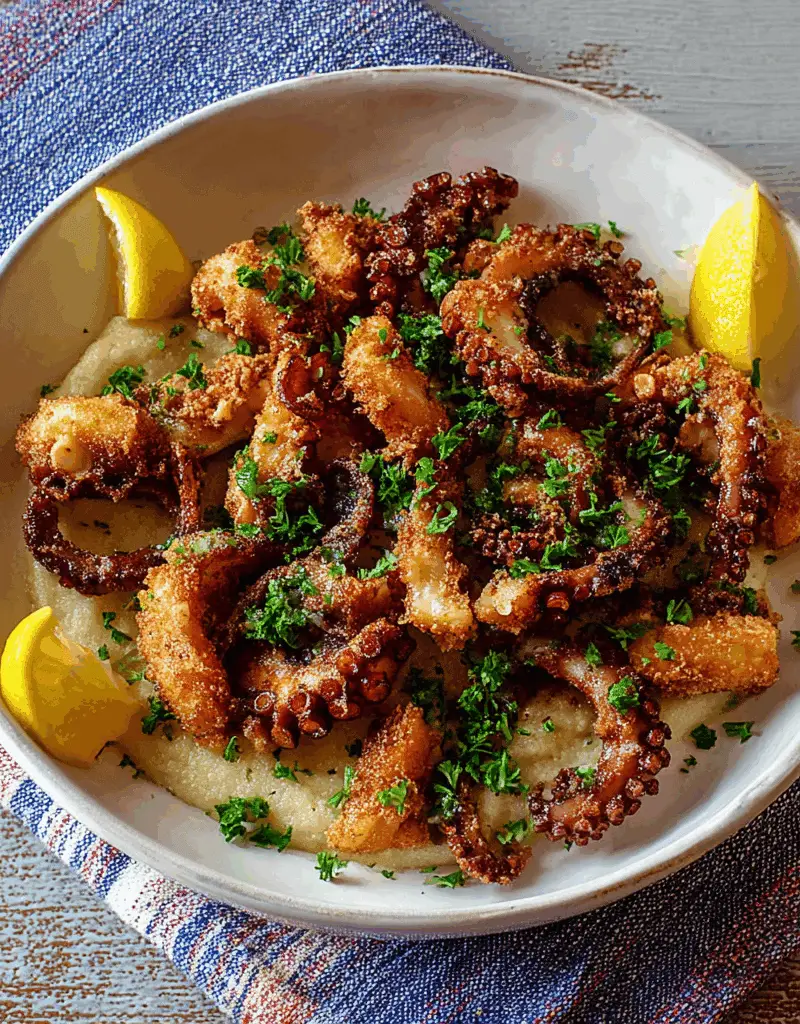The Italian Fried Octopus is a classic coastal delicacy, offering the perfect balance of tender seafood and crispy exterior. Cooked until golden and served with bright lemon wedges, it’s the kind of dish that transports you straight to a seaside café in Southern Italy.
This recipe is ideal for entertaining guests or indulging in a flavorful appetizer. The simplicity of ingredients allows the flavor of the octopus to shine, while the quick fry adds a satisfying crunch. Whether you’re hosting an Italian-themed dinner or just craving something unique, this dish delivers elegance with every bite.
Full Recipe
Ingredients:
-
2 pounds small baby octopus, cleaned
-
1/2 cup white wine vinegar
-
2 bay leaves
-
2 cloves garlic, crushed
-
Salt to taste
-
1 cup all-purpose flour
-
1/4 cup semolina flour
-
Vegetable oil, for frying
-
Lemon wedges, for serving
-
Fresh chopped parsley (optional)
Directions:
-
Rinse the baby octopus thoroughly under cold water.
-
In a large saucepan, add the octopus, vinegar, bay leaves, garlic, and a pinch of salt.
-
Cover with water and bring to a boil. Reduce heat and simmer for 30–40 minutes, or until the octopus is tender.
-
Drain the octopus and allow to cool. Pat dry with paper towels.
-
Cut large octopus into bite-sized pieces if needed.
-
In a bowl, mix the all-purpose flour and semolina flour together.
-
Dredge the octopus in the flour mixture, ensuring all pieces are well-coated.
-
Heat vegetable oil in a deep skillet or fryer to 375°F (190°C).
-
Fry the octopus in small batches until golden and crisp, about 2–3 minutes per batch.
-
Drain on paper towels and season with salt immediately.
-
Serve hot with lemon wedges and a sprinkle of fresh parsley if desired.
Prep Time: 15 minutes | Cooking Time: 45 minutes | Total Time: 1 hour
Kcal: 310 kcal | Servings: 4 servings
A Taste of the Sea: Exploring Italian Fried Octopus
In coastal Italy, where seafood reigns supreme and culinary traditions run deep, fried octopus holds a cherished place on the table. Whether served as a street food snack, an elegant antipasto, or the highlight of a seafood platter, this dish captures the heart of Mediterranean cooking with its crisp exterior, tender bite, and unmistakable ocean flavor. Italian Fried Octopus, or Polpo Fritto, is a celebration of simplicity, freshness, and technique—an ideal way to showcase the delicate nature of this often-overlooked sea creature.
Cultural Roots in Southern Italy
Fried octopus is a dish that tells a story—one of Southern Italian fishing villages, centuries-old recipes passed through generations, and the natural abundance of the Mediterranean Sea. This dish is especially beloved in regions like Campania, Calabria, and Sicily, where seafood is central to daily meals. In these areas, octopus is caught fresh and sold in local markets, often still wriggling, a sign of true freshness.
Local traditions dictate how it is prepared, with slight regional variations in seasoning and technique. Some might soak the octopus in milk to tenderize it, while others might infuse it with garlic and bay leaves before frying. Yet, the unifying trait is always the contrast in texture: crispy on the outside, succulent and juicy inside.
The Secret is in the Texture
Achieving the perfect fried octopus requires more than simply throwing it into hot oil. Octopus is a naturally tough meat, thanks to its muscular structure and high collagen content. This toughness, however, can be transformed into melt-in-your-mouth tenderness when properly handled.
The key lies in a preliminary simmering process. Before it ever touches the fryer, the octopus is slowly simmered in aromatic water—often with vinegar, garlic, and bay leaves—until tender. This not only breaks down the toughness but infuses the meat with subtle, earthy flavor. Once cooled and dried, it’s ready to be dusted with flour or semolina and crisped to perfection in hot oil.
The result? A golden, crackly exterior that gives way to buttery, ocean-kissed flesh. Every bite offers a symphony of textures that balances richness and crunch, delivering a sensory experience that’s both rustic and refined.
A Star at the Table
Italian Fried Octopus isn’t just a dish—it’s an experience. Its versatility makes it a favorite in a variety of culinary contexts. It can be served as:
-
A small-plate antipasto alongside olives, lemon wedges, and chilled white wine
-
A main dish paired with fresh salads, herb sauces, or crispy potatoes
-
A gourmet street food wrapped in parchment and sprinkled with sea salt
No matter the presentation, it always manages to steal the spotlight. It’s not uncommon to find it gracing wedding feasts, summer gatherings, or seafood-themed dinners throughout Italy and beyond.
Pairing and Presentation
Presentation matters, especially in Mediterranean cuisine. Italian Fried Octopus is best served immediately after frying, when the crust is still hot and crunchy. Lemon wedges are essential—not only do they brighten the flavors, but the acidity also cuts through the richness of the fried coating.
For a more upscale plating, it pairs beautifully with aioli, lemon-garlic crema, or even a light caper relish. A simple garnish of chopped parsley or microgreens adds a fresh note and visual contrast.
As for pairings, opt for crisp, acidic white wines like Vermentino, Falanghina, or Pinot Grigio. These varietals complement the oceanic notes without overpowering them, creating a harmony between food and drink that’s classic in Italian cuisine.
Why You Should Cook Octopus at Home
Octopus might seem intimidating at first glance—tentacles, suckers, and all—but it’s actually one of the most rewarding seafoods to cook at home. With a few key techniques, even beginner home cooks can achieve restaurant-level results.
Not only is octopus surprisingly affordable compared to other seafood like lobster or scallops, it’s also extremely versatile. Once cooked, it can be grilled, stewed, marinated, or fried. It soaks up flavor beautifully and takes on a luxurious texture when handled correctly.
Moreover, fried octopus offers an excellent alternative to heavier fried dishes like calamari or shrimp. Its meat is lean, low in fat, and packed with protein, iron, and B vitamins. If prepared using quality oil and fresh ingredients, it’s a dish that’s both indulgent and nourishing.
Common Mistakes and How to Avoid Them
Like any delicate seafood dish, fried octopus has its pitfalls. Here are some tips to avoid common mistakes:
Overcooking in the frying stage: Octopus should be fried quickly at high heat. Leaving it too long in the oil causes the coating to burn and the meat to dry out.
Skipping the pre-cooking step: If you don’t simmer the octopus before frying, you’ll likely end up with tough, rubbery bites. This step is not optional.
Not drying the octopus thoroughly: Any moisture left on the surface of the octopus will lead to soggy frying. Pat the pieces dry with paper towels before dredging in flour.
Using the wrong oil or temperature: Frying at too low a temperature causes the octopus to absorb oil and become greasy. Use a neutral oil with a high smoke point, like vegetable or sunflower oil, and maintain it at around 375°F (190°C).
Regional Twists on a Classic Dish
Although the traditional version calls for a basic flour or semolina coating, regional Italian kitchens have developed their own spins on fried octopus:
-
In Naples, it might be tossed in seasoned breadcrumbs with herbs before frying.
-
In Puglia, locals serve it alongside grilled vegetables and drizzle it with local olive oil.
-
Sicilian versions may include a sprinkle of chili flakes for added heat.
These variations reflect Italy’s rich culinary diversity while honoring the essence of the dish: quality seafood treated with care and minimal fuss.
Modern Takes and Creative Serving Ideas
In recent years, chefs have started to elevate fried octopus beyond its rustic roots. It now finds its way into gourmet restaurants and trendy food trucks alike. Here are some modern ideas:
-
Serve atop creamy polenta or chickpea puree
-
Drizzle with balsamic reduction or truffle oil
-
Add to tapas boards with roasted peppers and marinated anchovies
-
Skewer and grill briefly after frying for a smoky finish
These twists bring a new dimension to the dish, showing just how flexible and elegant it can be.
Conclusion: A Dish Worth Savoring
Italian Fried Octopus is more than just another seafood recipe—it’s a window into the culinary soul of the Mediterranean. With its balance of tradition, technique, and flavor, it exemplifies everything we love about Italian cooking: simplicity, respect for ingredients, and food meant to be shared.
Whether you’re an adventurous cook looking to try something new or a seasoned foodie with a love for coastal flavors, this dish is a must-have in your recipe repertoire. From its rich cultural history to its unmistakable crunch and zest, fried octopus is a timeless Italian classic that brings joy with every bite.
It reminds us that sometimes, the best meals come from the sea—and all they need is a little heat, a splash of lemon, and a lot of love.








